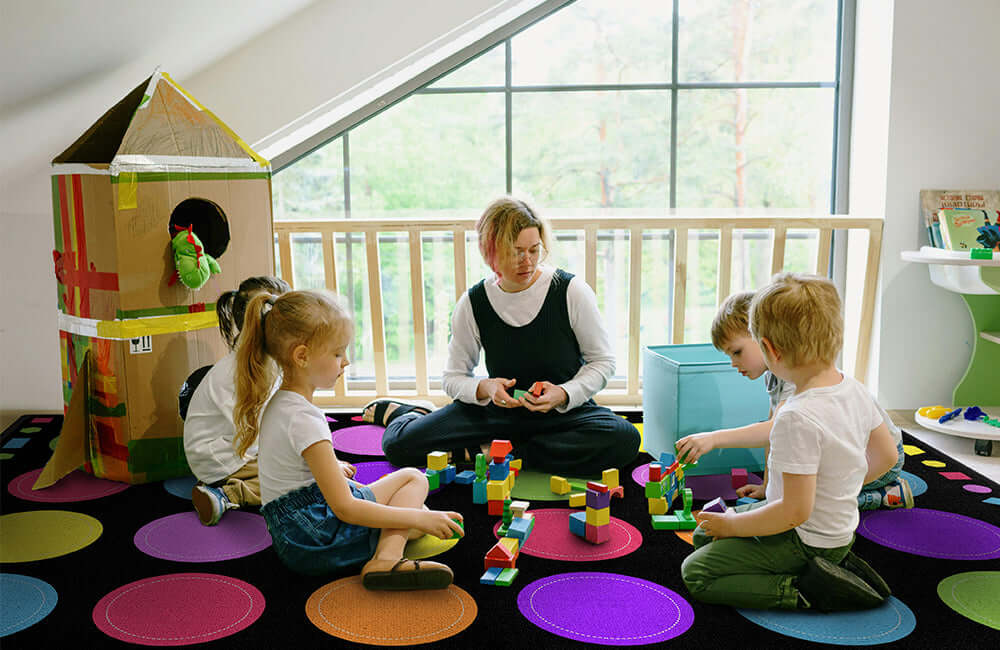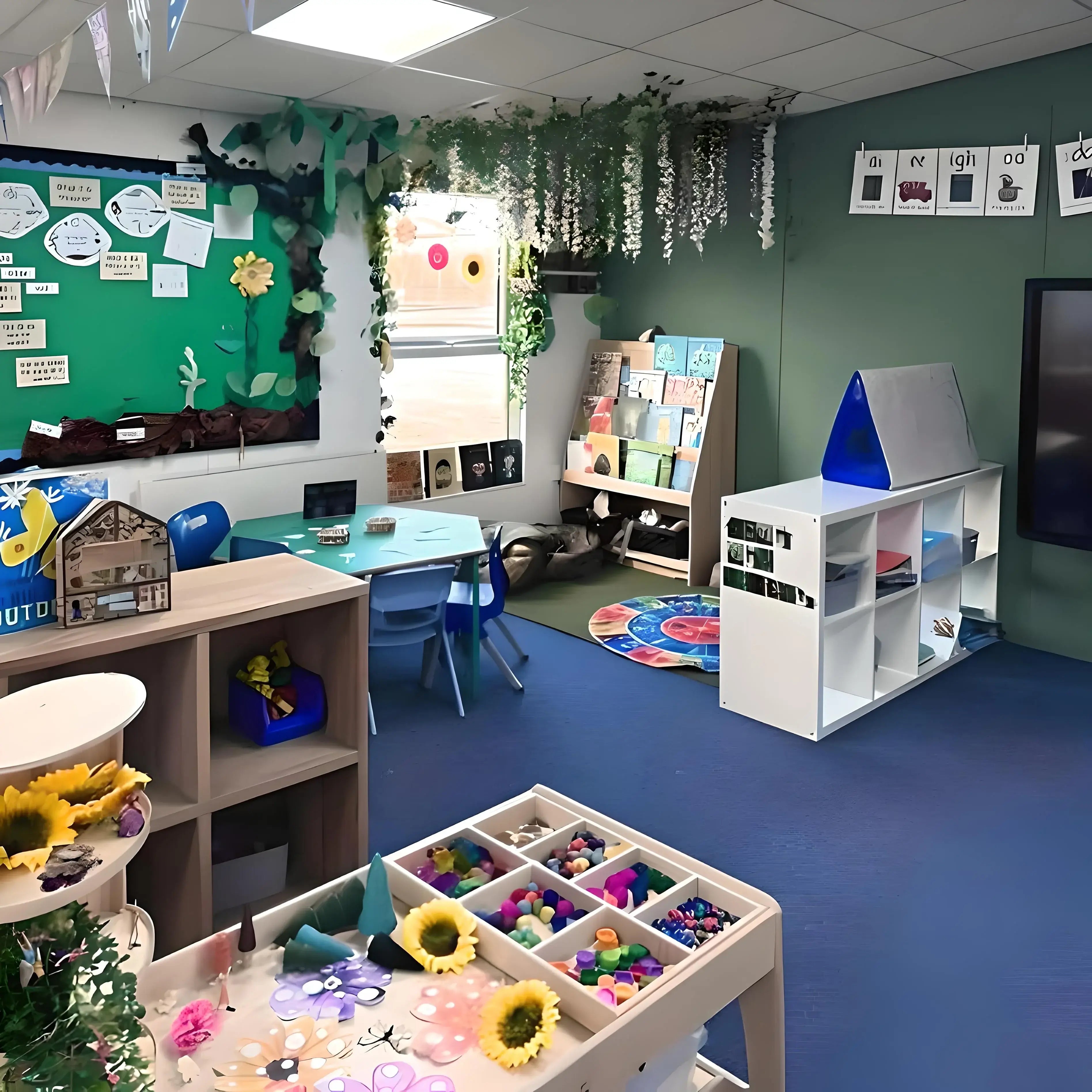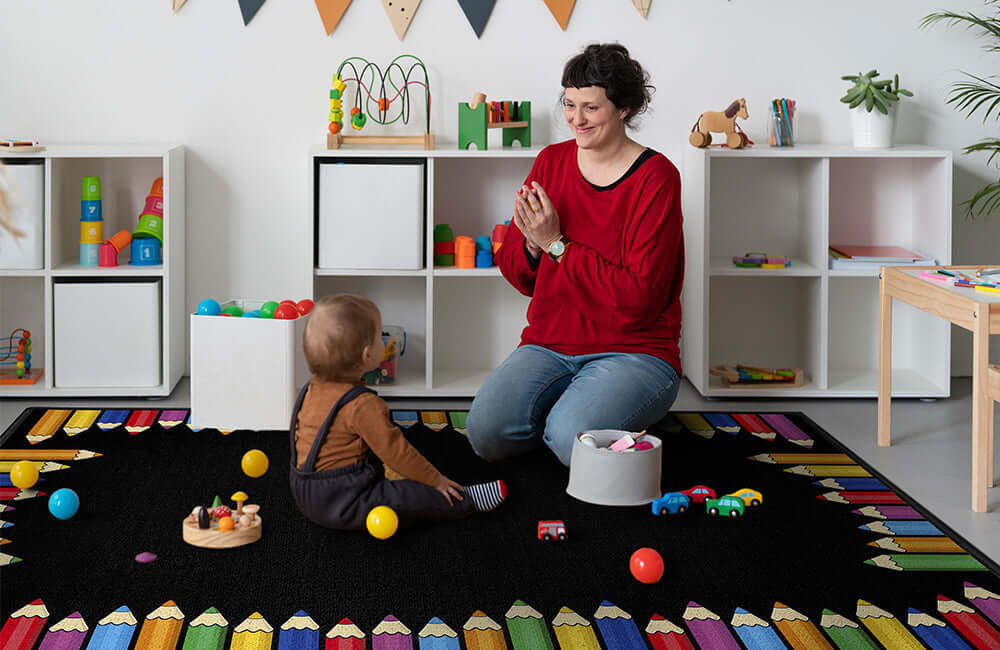The Psychology of Space Planning in Educational Settings
Every square foot of classroom space influences learning outcomes. Research from the Harvard Graduate School of Education demonstrates that thoughtfully designed learning environments can increase student achievement by up to 25%.
Classroom rugs play a crucial role in this environmental psychology by creating defined spaces that help students understand behavioral expectations and learning objectives.
When students enter a classroom with clearly defined zones, they instinctively recognize where different activities occur.
A reading rug signals quiet, focused time, while a large gathering rug indicates group discussion areas.
This visual communication reduces confusion and helps students transition smoothly between activities.
Spatial Boundaries and Behavior Management: Rugs create natural boundaries without physical barriers, allowing for flexible space use while maintaining organization.
Students understand that the rug defines their learning space, which often leads to improved focus and reduced disruptions.
Comfort and Engagement: Physical comfort directly impacts learning capacity.
Soft rug surfaces encourage students to sit on the floor for extended periods, facilitating closer teacher-student interactions and peer collaborations that might not occur with traditional desk arrangements.
Strategic Rug Placement for Maximum Learning Impact
Successful classroom space planning begins with understanding traffic patterns and learning objectives.
Before selecting or placing any classroom rugs, map out how students and teachers move through the space during typical daily activities.
Entry Zone Planning: Position a welcoming rug near the classroom entrance to create a transition space between hallway energy and classroom focus.
This entry rug should be large enough to accommodate several students at once but positioned to avoid blocking the main pathway into the room.
Central Gathering Areas: Most classrooms benefit from one primary gathering rug that can accommodate the entire class for circle time, read-alouds, or group discussions.
This rug should be positioned where all students can see the teacher and any display boards or screens without neck strain.
Plan for approximately 2-3 square feet per student when calculating gathering rug size.
A class of 25 students needs roughly 50-75 square feet of rug space, typically requiring an 8x10 or 9x12 foot rug for comfortable seating.
Learning Center Rugs: Smaller rugs define specific learning centers such as reading corners, math manipulative areas, or science observation stations.
These rugs should complement the main gathering rug while serving distinct functional purposes.
For comprehensive classroom design strategies, explore our detailed guide on affordable inclusive classrooms that work for every learning style.
Size and Scale Considerations for Different Classroom Layouts
Classroom shapes and sizes vary dramatically, requiring flexible approaches to rug selection and placement.
Understanding how different rug dimensions work in various spaces helps optimize your classroom layout.
Standard Rectangular Classrooms: Most traditional classrooms measure approximately 24x32 feet, providing roughly 750 square feet of space.
In these rooms, a single large gathering rug (8x10 feet) works well in one corner, leaving adequate space for desks, storage, and movement.
Square Classrooms: Square layouts often work better with multiple medium-sized rugs rather than one large central rug. This approach creates distinct learning zones while maintaining visual cohesion through coordinated colors or patterns.
Open Concept Spaces: Larger, open classrooms or combined learning spaces require careful rug placement to create intimate learning zones within the broader space.
Multiple rugs help break up vast areas into manageable, comfortable learning environments.
Small or Irregular Spaces: Compact classrooms benefit from custom-sized rugs or creative arrangements of smaller rugs that maximize available floor space while still providing comfortable gathering areas.
Color Psychology and Pattern Selection for Learning Environments
The visual impact of classroom rugs extends far beyond mere decoration. Colors and patterns influence mood, attention levels, and learning capacity in measurable ways.
Calming Colors for Focus: Blues, greens, and earth tones—like those found in our pastel classroom rugs—promote concentration and reduce anxiety levels.
These colors work particularly well in reading areas or spaces designated for quiet, independent work.
Energizing Colors for Active Learning: Warmer colors like oranges, reds, and yellows—often featured in our colorful classroom rugs—can stimulate discussion and creative thinking.
Use these colors strategically in areas where you want to encourage participation and collaborative activities.
Pattern Considerations: Busy patterns can be distracting for students with attention difficulties or sensory processing challenges. Simple, geometric patterns or subtle textures often work better than complex designs with multiple focal points.
The Center for Health Design provides research-based guidelines for creating supportive environments that consider diverse learning needs and sensory preferences.
Creating Flexible Learning Zones with Strategic Rug Placement
Modern education emphasizes flexibility and adaptability in learning environments. Classroom rugs should support multiple teaching strategies and learning configurations throughout the day.
Modular Rug Systems: Instead of one large rug, consider multiple smaller rugs—like those from our by-style classroom rugs—that can be rearranged as needed.
This approach allows for small group work, partner activities, or individual learning spaces depending on lesson requirements.
Seasonal Adaptability: Plan rug placement that accommodates seasonal activities and curriculum changes.
Rugs should be positioned to allow for holiday celebrations, science experiments, art projects, or other special activities—using adaptable options like our circle time rugs.
Multi-Purpose Areas: Design rug areas that serve multiple functions. A morning meeting rug can become an afternoon reading space, or a math center rug can double as a presentation area for student projects.
Traffic Flow and Safety Considerations
Effective space planning prioritizes both functionality and safety. Classroom rugs must enhance learning while maintaining clear pathways and emergency egress routes.
Pathway Planning: Ensure major walkways remain unobstructed by rug placement. Students should be able to move between desks, learning centers, and the exit without navigating around rug edges or corners.
Edge Management: Rug edges create tripping hazards if not properly secured. Use rug tape, carpet strips, or choose rugs with bound edges that lie flat against the floor surface.
Emergency Considerations: Plan rug placement that doesn't impede emergency evacuation routes. While creating cozy learning spaces is important, safety requirements must take precedence in all layout decisions.
Storage and Maintenance Integration
Successful classroom space planning considers both daily use and long-term maintenance requirements. Rug placement should facilitate easy cleaning and seasonal storage when necessary.
Cleaning Access: Position rugs where they can be easily vacuumed or spot-cleaned without moving excessive furniture. Consider the location of electrical outlets for vacuum cleaners and the accessibility of cleaning supplies.
Replacement Planning: Design your layout to accommodate rug rotation or replacement without major classroom disruption. Having a flexible system allows for deep cleaning, repairs, or seasonal changes.
For practical maintenance strategies, visit our comprehensive resource on classroom space planning that includes detailed care instructions.
Technology Integration and Modern Learning Needs
Contemporary classrooms must accommodate various technologies while maintaining comfortable, flexible learning spaces.
Rug placement should consider power sources, projection areas, and device usage patterns.
Interactive Display Areas: Position gathering rugs to optimize viewing angles for interactive whiteboards, projectors, or large monitors.
Students should be able to see displays clearly without neck strain or awkward positioning.
Device Charging Considerations: Modern students often use tablets, laptops, or other devices during floor activities.
Plan rug placement near electrical outlets or ensure extension cords can be safely routed to learning areas.
Audio Considerations: Rugs help absorb sound, which becomes increasingly important as classrooms incorporate more audio-visual elements.
Strategic rug placement can improve acoustics for both technology use and traditional instruction.
Budget-Conscious Space Planning Strategies
Effective classroom space planning doesn't require expensive overhauls. Strategic rug selection and placement can transform learning environments within modest budgets.
Phased Implementation: Start with one high-impact rug in your primary gathering area, then gradually add smaller rugs to learning centers as budget allows.
This approach lets you test layouts and student responses before making major investments.
Multi-Functional Selections: Choose rugs that serve multiple educational purposes. A world map rug supports both geography lessons and general gathering activities, maximizing your investment value.
Community Resources: Many communities have businesses or organizations willing to donate or discount educational materials. Local carpet stores often have remnants suitable for classroom use at significant savings.
Special Considerations for Inclusive Learning Environments
Inclusive classroom design ensures all students can participate fully in learning activities. Rug selection and placement must consider diverse physical, sensory, and learning needs.
Mobility Accommodations: Ensure rug areas remain accessible for students using wheelchairs, walkers, or other mobility aids. Low-pile rugs work better than high-pile alternatives for wheeled mobility devices.
Sensory Considerations: Some students with autism or sensory processing differences may be sensitive to certain textures or patterns.
Provide alternative seating options near rug areas for students who cannot comfortably sit on floor surfaces.
Visual Accommodations: High-contrast borders help students with visual impairments navigate rug boundaries. Consider the lighting in rug areas to ensure adequate visibility for all students.
The Universal Design for Learning Guidelines from CAST provide excellent frameworks for creating inclusive learning environments that work for all students.
Measuring Success: Evaluating Your Space Planning Decisions
Effective space planning requires ongoing evaluation and adjustment. Monitor how students use rug areas and be prepared to make changes based on observed behaviors and learning outcomes.
Student Engagement Metrics: Track how often students choose to use rug areas for independent activities, peer collaborations, or teacher-directed lessons.
High usage rates typically indicate successful space planning.
Behavioral Observations: Note whether rug areas contribute to improved focus, reduced disruptions, or better participation in group activities. Positive behavioral changes suggest effective environmental design.
Academic Performance Connections: While many factors influence academic achievement, improved learning environments often correlate with better student outcomes.
Monitor whether classroom changes coincide with improved performance metrics.
Seasonal Adaptations and Long-Term Planning
Successful classroom space planning anticipates changing needs throughout the school year. Plan rug layouts that can adapt to seasonal activities, curriculum changes, and evolving classroom dynamics.
Holiday and Celebration Accommodations: Ensure rug arrangements can accommodate special events, parties, or cultural celebrations without major disruption to daily learning routines.
Curriculum Alignment: As curriculum focus shifts throughout the year, rug areas may need to serve different purposes.
Plan flexible arrangements that support science fair preparations, standardized testing accommodations, or end-of-year activities.
Growth and Change: Student needs evolve throughout the school year as they develop new skills and comfort levels.
Be prepared to adjust rug arrangements to support growing independence and changing social dynamics.
Creating an effective classroom space plan with strategic rug placement requires balancing multiple considerations: safety, functionality, budget, and educational goals.
The most successful approaches start with understanding your specific student population and teaching style, then gradually implementing changes that support your educational objectives.
Remember that the best classroom layout is one that serves your students' learning needs while supporting your teaching effectiveness.
Whether you're working with a large budget or modest resources, thoughtful rug selection and placement can significantly improve your learning environment.




Leave a comment
This site is protected by hCaptcha and the hCaptcha Privacy Policy and Terms of Service apply.